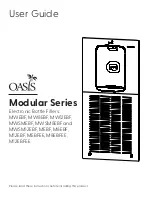
14
Pumping gases with molecular mass
≥
40 with
the incorrect gas mode can cause damage to
the pump.
For the vertex of the power characteristic line please refer to
Section 8. Technical Data.
Maximum power is applied when the pump starts in order to
limit the time required. Once the set rotation speed is
attained, switching to the selected power characteristic line
is automatic.
If the gas dependent maximum power is exceeded, the rotati-
on speed is reduced until equilibrium between the
permissible power and gas friction is attained. The power
limitation serves to protect the pump against thermal over-
loading. In order to avoid rotation speed fluctuations it is
recommended to set, in rotation speed setting mode, the
equilibrium frequency or a somewhat lower frequency.
Please note:
There can be types of pump whereby there is no differentiati-
on between the two ”gas modes” settings.
4.4. Circulatory Lubrication
The ball bearing on the fore-vacuum side is supplied with
lubricant via the lubricating pump.
The circulation of the lubricant is monitored via a switching
contact. If there is insufficient lubricant, the electronic drive
unit switches off the turbopump. Monitoring is active only
from 60% of the final rotation speed.
If, at a rotation speed of > 60% of the final rotation speed (for
example through the degassification of the lubricant), the
contact opens for
≥
2 minutes, the electronic drive unit assu-
mes a lubricant deficiency and switches off the turbopump.
➡
Check the filling level of the lubricant.
➡
Re-start the turbopump with switch S1 on the power pack
unit.
4.5. Heating
Heating turbopumps and vacuum chambers accelorates the
attainment of final pressures.
The heating period is dependent on the level of contamination
and the required final pressure. Heat for at least four hours.
4.6. Switching OFF And Venting
To avoid contamination occurring when switching off, the
pump should be vented before shut-down.
➡
Switch off both turbopump and backing pump on the
power pack unit at the same time with switch S1.
➡
With the Venting Valve TVF 005 the turbopump is vented
automatically.
➡
Shut off water supply.
4.7. Gas Type Dependent Operations
Water cooling is required if the pumps are to be
operated with gas load.
Where high level gas loads and rotation speeds are involved,
the resulting friction subjects the rotor to the effect of great
heat. To avoid over-heating, a power rotation speed charac-
teristic line is implemented in the TC 600; this ensures that
where maximum gas loads are involved, the pump will opera-
te at any rotation speed without the danger of damage
arising.
The maximum power is dependent on the type of gas. Two
characteristic lines are available for any type of gas in order
to fully exploit the power potential of the pump:
– "Gas-Mode 0" for gases with molecular mass
≥
40 as, for
example, Argon;
– "Gas-Mode 1" for all lighter gases.
➡
Set the applicable gas mode with the DCU 001 or DCU 100
(please refer to Operating Instructions ”Pumping
operations with the DCU” PM 800 547 BN).
Power
Frequency
D
B
C
A
D-C = Gas mode «0»
B-A = Gas mode «1»
Run up
fnom
Gas type characteristic line
4.8. Shutting Down For Longer Periods
Vacuum pumps are sometimes used to pump
aggressive or hazardous gases. There is a dan-
ger of personal injury resulting from coming into
contact with process gases. Before removing a
turbopump from the system, first:
–
Vent the turbopump with a neutral gas or
dry air.
– Ensure that there is no residual process gas in the system
nor in the feeder lines.
If the turbopump is to be shut down for more than a year:
➡
Remove turbopump from the system.
➡
Change the lubricant (see Section 8.1.).
Please note:
Lubricant TL 011 must no longer be used after
2 years
of non-operations.
➡
Close the high vacuum flange and evacuate the turbopump
via the fore-vacuum flange.
➡
Vent turbopump via the venting connection with nitrogen
or dry air.
Summary of Contents for TPH 2201
Page 11: ...11 3 12 Connections Diagram 1 1...
Page 12: ...12 Connection Diagram For 3 phase Backing Pump...
Page 23: ...23 Spare parts...














































